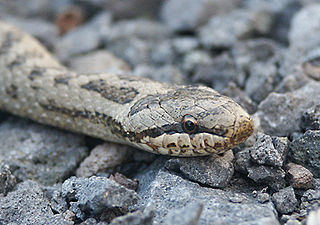Lizards
| Image | Name |
|---|---|
 | Slow worm (Anguis fragilis) |
 | Viviparous lizard (Zootoca vivipara) |
This is a list of reptiles of Finland . There are five species and all are protected by law. Currently Coronella austriaca is classified as vulnerable. [1]
| Image | Name |
|---|---|
 | Slow worm (Anguis fragilis) |
 | Viviparous lizard (Zootoca vivipara) |
| Image | Name | Head (dorsal) | Head (lateral) |
|---|---|---|---|
 | Common adder (Vipera berus) |  |  |
 | Grass snake (Natrix natrix) |  |  |
 | Smooth snake (Coronella austriaca) |  |  |

Finland, officially the Republic of Finland, is a Nordic country in Northern Europe. It borders Sweden to the northwest, Norway to the north, and Russia to the east, with the Gulf of Bothnia to the west and the Gulf of Finland to the south, opposite Estonia. Finland covers a total area of 338,145 square kilometres (130,559 sq mi), including a land area of 303,815 square kilometres (117,304 sq mi), and has a population of 5.6 million. Helsinki is the capital and largest city. The vast majority of the population are ethnic Finns. The official languages are Finnish and Swedish; 84.9 percent of the population speak the first as their mother tongue and 5.1 percent the latter. Finland's climate varies from humid continental in the south to boreal in the north. The land cover is predominantly boreal forest biome, with more than 180,000 recorded lakes.

The Finnish Civil War was a civil war in Finland in 1918 fought for the leadership and control of the country between White Finland and the Finnish Socialist Workers' Republic during the country's transition from a grand duchy ruled by the Russian Empire to a fully independent state. The clashes took place in the context of the national, political, and social turmoil caused by World War I in Europe. The war was fought between the Red Guards, led by a section of the Social Democratic Party, and the White Guards, conducted by the senate and those who opposed socialism with assistance late in the war by the German Imperial Army at the request of the Finnish civil government. The paramilitary Red Guards, which were composed of industrial and agrarian workers, controlled the cities and industrial centres of southern Finland. The paramilitary White Guards, which consisted of land owners and those in the middle and upper classes, controlled rural central and northern Finland, and were led by General C. G. E. Mannerheim.

The national flag of Finland, also known in Finnish as the Siniristilippu, dates from the beginning of the 20th century. On a white background, it features a blue Nordic cross, which represents Christianity.

The Christian Democrats is a Christian-democratic political party in Finland.

The Centre Party, officially the Centre Party of Finland, is an agrarian-centrist political party in Finland. Ideologically, the Centre Party is positioned in the centre of the political spectrum. It has been described as liberal, social-liberal, liberal-conservative, and conservative-liberal. The party’s leader is Antti Kaikkonen, who was elected in June 2024 to succeed former minister Annika Saarikko. As of June 2023, the party has been part of the parliamentary opposition.

Ilta-Sanomat is one of Finland's two prominent tabloid size evening newspapers and the second largest paper in the country. Its counterpart and biggest rival is Iltalehti.

The whooper swan, also known as the common swan, is a large northern hemisphere swan. It is the Eurasian counterpart of the North American trumpeter swan, and the type species for the genus Cygnus.

The smooth snake is a species of non-venomous snake in the family Colubridae. The species is found in northern and central Europe, but also as far east as northern Iran. The Reptile Database recognizes two subspecies as being valid, including the nominotypical subspecies described here.

The Finnish Socialist Workers' Republic (FSWR), more commonly referred to as Red Finland, was a self-proclaimed socialist state in Finland during the Finnish Civil War from January to May 1918.
Suomen Kuvalehti is a weekly Finnish language family and news magazine published in Helsinki, Finland.

Hydrophis is a genus of sea snakes, venomous snakes in the subfamily Hydrophiinae of the family Elapidae. Species in the genus Hydrophis are typically found in Indo-Australian and Southeast Asian waters. Currently, around 36 species are recognized as being valid.
The Official Finnish Charts are national record charts in Finland compiled and published by Musiikkituottajat – IFPI Finland. The name Suomen virallinen lista/Finlands officiella lista, which is singular in both Finnish and Swedish, is used generically to refer to both the albums and the singles chart, and the context reveals which chart is meant.

Cucujus cinnaberinus is a species of beetles in the family Cucujidae, the flat bark beetles. It is native to Europe, being most common in Central Europe and rare in much of Southern and Western Europe.

Salix myrsinifolia, known as the dark-leaved willow or myrsine-leaved willow, is a species of willow native to Europe and Western Siberia. It forms a 2–5 m (6.6–16.4 ft) high shrub. In the north it often becomes a tree up to 8 m (26 ft) tall.

The wildlife of Finland is affected by prevailing environmental conditions. The phytogeography of Finland is shared between the Arctic, central European, and northern European provinces of the Circumboreal Region within the Boreal Kingdom. The territory of Finland can be subdivided into three ecoregions: the Scandinavian and Russian taiga, Sarmatic mixed forests, and Scandinavian montane birch forest and grasslands. Taiga covers most of Finland from northern regions of southern provinces to the north of Lapland. On the southwestern coast, south of the Helsinki-Rauma line, forests are mixed as is more typical in the Baltic region. In the extreme north of Finland, near the tree line and Arctic Ocean, montane birch forests are common.
Agathidium pulchellum is a species of round fungus beetle in the family Leiodidae. This species is one of the rarest of the genus Agathidium. It feeds exclusively on a slime mold species named Trichia decipens with mid-decayed aspen, spruce and birch logs in boreal forests. It is found only in natural forests where there is a ratio of at least 80 aspen and spruce logs per hectare. It was first discovered in 1971 in Blåkölen in Norrbotten, Sweden. A. pulchellum is considered an endangered species in Sweden, and Finland.